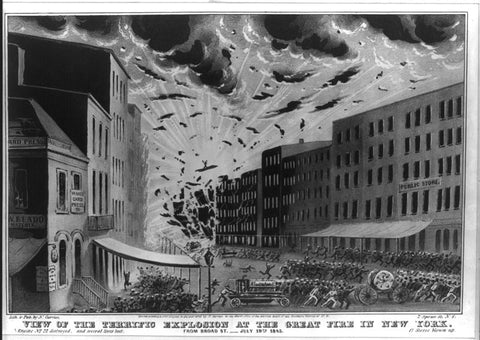Hook and Irons
The Last Great Fire of New York City - 1845 September 04 2013, 0 Comments
Before dawn on July 19, 1845 a fire broke out on the third floor of a whale oil store on New Street (located in lower Manhattan). An influx of early morning business and mild summertime temperatures might have aided in putting a quick stop to the blaze, but a warehouse located just a block away from the oil store was filled with a new shipment of salt peter (which is used in the manufacture of gunpowder). Fire spreading from the oil store extended through the warehouses iron shutters and caused, 'a series of cannon-like bursts of smoke and fire, almost like a volcano, smashing into buildings across the street. It culminated in a terrible final explosion completely engulfing the city block.' The blast was heard as far away as Sandy Hook, NJ.

The fire killed 4 firefighters (volunteers as the FDNY was not a paid department for another 20 years) and 26 citizens. Before the fire was contained and extinguished it destroyed 345 buildings and caused nearly 7 million dollars in damage. With all that devastation, the fire could have been worse. The Last Great Fire of NY was the the third in a series of horrific blazes. The first and second of which occurred in 1776 and 1835. The result of the first two fires was a change in building codes. All new buildings built in New York City had to be made of brick and mortar. This code and the newer stone buildings helped to slow the spread of the blaze and aid in its containment. The other significant aid to extinguishing the blaze was the recent completion of the Croton Resevoir which provided a steady supply of water throughout the conflagration.

Here is an excerpt from a witness account of the blaze.
". . .an immense body of flame... it instantly penetrated at least seven buildings, blew in the fronts of the opposite houses on Broad Street, wrenched shutters and doors from buildings at some distance from the immediate scene of the explosion, propelled bricks and other missiles through the air, threw down many individuals who had gone as far as Beaver Street, spread the fire far and wide, so that the whole neighborhood was at once in a blaze, and most unfortunately covered up the [fire company's] hose.... After this the firemen could with difficulty obtain any control over the conflagration."
Inspiration
When we contacted Ryan Brown from the Pursuit of NY, we gave him very simple instructions. We wanted him to create a design that was historically significant to New York's history. We wanted it to be a fresh, new look for a t-shirt. The rest was up to him. We knew the problem wouldn't be coming up with an idea, more honing in on one great idea. The Last Great Fire tee is the result of all his research. The whale represents the whale oil store that was responsible for the blaze. The whale is also drawn into a rough shape of Manhattan and the blaze escaping from his mouth is roughly where the fire started. Located on the top and bottom of the whale are map icons for the East and North River with an anchor showing north and south and the date of the fire.

The Last Great Fire of New York City encompasses everything we look for when we make a shirt--a design that stands alone on its own merit and becomes more interesting once you learn the story behind the design. Ryan Brown is one of the great talents we've come across since starting H&I and if you're looking for cutting edge designs from one of the hippest indie labels out there, you should check him out at Pursuit of NY.
Historical Novel
While researching The Last Great Fire, I came across a mystery novel that takes place in 1845 New York and includes the The Last Great Fire in the novel. The Gods of Gotham written by Lyndsay Faye was one of Publishers Weeklys top ten Mystery/Thriller novels of the year. Lyndsay spent over a year researching the book before writing it and by all accounts is very historically accurate. Beyond that, I would recommend it as a very easy read.
The Last Great Fire of New York City changed the building codes in New York City and eventually played a part in unifying the fire service into what would become FDNY as we know it today. We're proud to release this shirt and recognize that from the ashes we rise and continue the mission of making the fire service better than it was before we found it.


